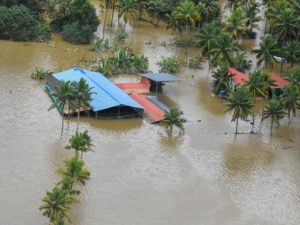
Kerala’s Deadly Floods May Have Been Due To Life-Threatening Dams
Kochi/Mumbai: A farmer wakes up from sleep during night after he hears an unusual sound of rushing waters and much to his astonishment, within hours, all the plantations he owned get completely submerged into the waters.

“There was absolutely no warning from the government side,” said Pathrose, while he was telling the whole tale of the devastating flooding that hit the village of Okkal on August 15. Mr. Pathrose says that local authorities told him that all his fields were completely safe, despite the ongoing incessant rains that destroyed much of Kerala during the monsoon.
Due to the torrential rain, more than 5 million people in Kerala bore the brunt and more than 200 were killed in the month of August. Called as the worst to hit the southern nearly in a century, let to billion of dollars of loss to homes, fields and other infrastructure.

Authorities were forces to release water from about 35 dams to contain the rising water levels in reservoirs as the rain intensified in mid-August state. Many of those reservoirs were used to generate hydroelectricity.
According Mr. Pathrose and many others living in the area of Periyar, the devastation was caused by many factors which included the sudden opening of dam gates without taking up campaigns for proper warnings for those living downstream.
“Because of this carelessness the disaster proportions were multiplied,” said Himanshu Thakkar, co-ordinator of the South Asia Network of Dams, Rivers and People (SANDRP), a non-governmental body that promotes better water management practices.
The sudden release of dam water without proper warnings has invited sharp criticism from some water management experts and this in turn has put a focus on reservoir operations and the strong need for better flood mapping and warning systems to be put in place across the country.
As per the claims made by the state government officials with respect to the reason behind the severity of floods, it was once-in-a-century storm that resulted in such consequences, and the spilling of dam water had a very little impact on the situation.
There are two largest reservoirs in the state of Kerala, namely Idukku and Idamalayar. Both of them have been operating in the country for many years without any kind of emergency action plans which is a basic requirement before building major dams all over the globe. The reservoirs also did not had “rule curves”, which plays as another safety protocol that lets you know the safe level of water in the dam that is needed to be maintained without transgressing at any given point with seasonal factors.
All these protocols are recommended by the CWC, but are not covered under the law to make it mandatory. The stance by CWC is that it is nothing more than being an advisory body and it hopes a new dam safety bill to be introduced, so that dam operators may be held accountable for any violations.
As per the analyzation done with the historical data, both the reservoirs were maintaining more than 90 percent of their fullest extent of capacity on August 2, or it can be said that more than double their 10-year historical averages for that given time of the year.
According to the management experts, such levels were very dangerous specially for the middle of the monsoon season.
“One of the key advantages of a dam is it can help moderate floods,” said SANDRP’s Thakkar, who is an engineering graduate from the Indian Institute of Technology in Mumbai. “That didn’t happen as Kerala’s dams were already full by end-July. Dams aren’t supposed to be full before the end of the monsoons.”
You May Also Read: Rahul Reiterates His Stance of Prime Minister Being Corrupt After New Report On Rafale